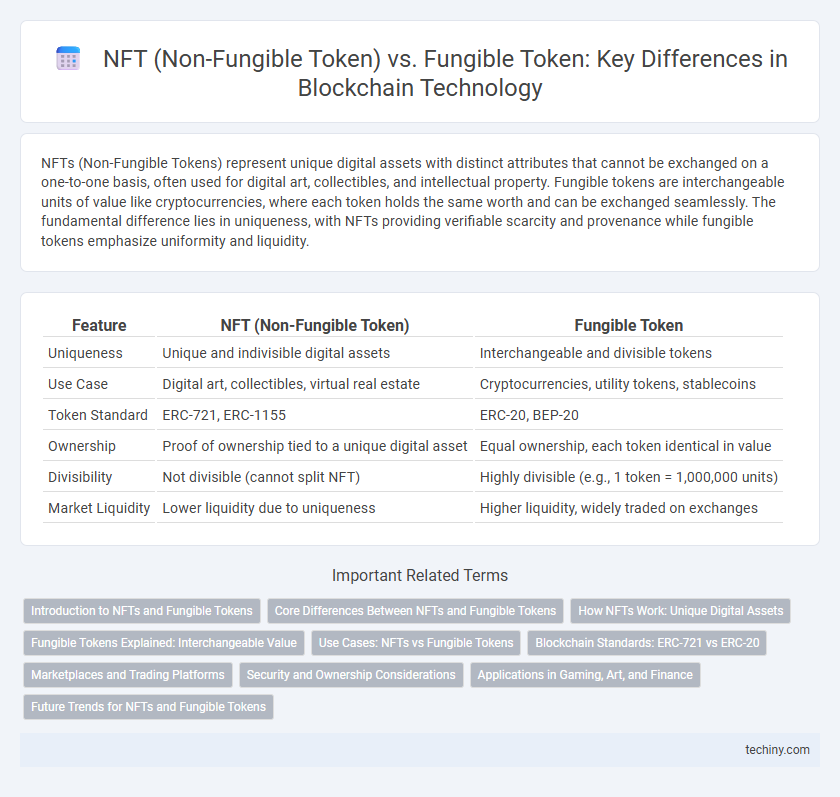NFTs (Non-Fungible Tokens) represent unique digital assets with distinct attributes that cannot be exchanged on a one-to-one basis, often used for digital art, collectibles, and intellectual property. Fungible tokens are interchangeable units of value like cryptocurrencies, where each token holds the same worth and can be exchanged seamlessly. The fundamental difference lies in uniqueness, with NFTs providing verifiable scarcity and provenance while fungible tokens emphasize uniformity and liquidity.
Table of Comparison
| Feature | NFT (Non-Fungible Token) | Fungible Token |
|---|---|---|
| Uniqueness | Unique and indivisible digital assets | Interchangeable and divisible tokens |
| Use Case | Digital art, collectibles, virtual real estate | Cryptocurrencies, utility tokens, stablecoins |
| Token Standard | ERC-721, ERC-1155 | ERC-20, BEP-20 |
| Ownership | Proof of ownership tied to a unique digital asset | Equal ownership, each token identical in value |
| Divisibility | Not divisible (cannot split NFT) | Highly divisible (e.g., 1 token = 1,000,000 units) |
| Market Liquidity | Lower liquidity due to uniqueness | Higher liquidity, widely traded on exchanges |
Introduction to NFTs and Fungible Tokens
NFTs (Non-Fungible Tokens) represent unique digital assets verified on a blockchain, making each token distinct and irreplaceable. Fungible tokens, such as cryptocurrencies like Bitcoin or Ethereum, are interchangeable units with equal value, facilitating seamless transactions and liquidity. Understanding the fundamental differences between NFTs and fungible tokens is essential for leveraging blockchain technology in digital ownership and decentralized finance.
Core Differences Between NFTs and Fungible Tokens
NFTs (Non-Fungible Tokens) represent unique digital assets with distinct identifiers, enabling proof of ownership and authenticity on a blockchain, while fungible tokens are interchangeable units of the same type, such as cryptocurrencies like Bitcoin or Ethereum. NFTs are indivisible and cannot be exchanged on a one-to-one basis, contrasting with fungible tokens that maintain consistent value and are divisible into smaller units. The core difference lies in uniqueness and interchangeability, with NFTs facilitating digital collectibles and art, and fungible tokens serving as currency or utility tokens in decentralized networks.
How NFTs Work: Unique Digital Assets
NFTs (Non-Fungible Tokens) operate on blockchain technology to create unique digital assets that cannot be exchanged on a one-to-one basis due to their distinct properties. Each NFT contains metadata and a unique identifier stored on the blockchain, ensuring provenance, ownership verification, and scarcity. Unlike fungible tokens such as cryptocurrencies, NFTs represent individual items like digital art, music, or collectibles that hold distinct value and authenticity.
Fungible Tokens Explained: Interchangeable Value
Fungible tokens represent interchangeable digital assets with identical value, such as cryptocurrencies like Bitcoin and Ethereum, enabling seamless trading and liquidity. Each fungible token unit holds equal value and can be exchanged one-to-one without loss of worth, unlike NFTs which are unique and indivisible. This interchangeable nature makes fungible tokens ideal for currency, payments, and utility within blockchain ecosystems.
Use Cases: NFTs vs Fungible Tokens
NFTs enable unique digital asset ownership in industries like art, gaming, and real estate by providing verifiable scarcity and provenance. Fungible tokens support scalable transactions, serving as currency or utility tokens in decentralized finance, payment systems, and governance models. While NFTs excel in representing one-of-a-kind assets, fungible tokens facilitate seamless divisible value exchange across various blockchain ecosystems.
Blockchain Standards: ERC-721 vs ERC-20
ERC-721 and ERC-20 are Ethereum blockchain standards defining Non-Fungible Tokens (NFTs) and Fungible Tokens, respectively. ERC-721 tokens represent unique digital assets with distinct identifiers, enabling the creation of collectibles, art, and real estate NFTs, while ERC-20 tokens are interchangeable and divisible, commonly used for cryptocurrencies and utility tokens. The smart contract implementations for ERC-721 include metadata and ownership tracking specific to each token, contrasting with the uniform balance tracking and transfer functions in ERC-20 contracts.
Marketplaces and Trading Platforms
NFT marketplaces like OpenSea and Rarible specialize in unique digital assets that prove ownership and authenticity, leveraging blockchain technology to enable secure peer-to-peer trading. Fungible token platforms such as Binance and Coinbase facilitate the exchange of interchangeable cryptocurrencies like Bitcoin and Ethereum, supporting high liquidity and standardized value. These trading ecosystems utilize smart contracts to streamline transactions, enforce provenance, and enhance market transparency for both token types.
Security and Ownership Considerations
NFTs provide unique ownership records secured through blockchain's immutable ledger, ensuring provenance and reducing risks of duplication or fraud. Fungible tokens offer interchangeable assets with standardized security protocols but lack individual traceability, making them more prone to bulk security breaches. Ownership of NFTs is distinct and verifiable, whereas fungible tokens represent shared value without exclusive possession rights.
Applications in Gaming, Art, and Finance
NFTs (Non-Fungible Tokens) provide unique digital ownership and provenance, revolutionizing gaming by enabling players to own, trade, and monetize rare in-game assets securely on the blockchain. Fungible tokens, such as cryptocurrencies, facilitate seamless transactions and liquidity within gaming economies and decentralized finance (DeFi) platforms. In the art world, NFTs authenticate digital artworks and collectibles, while fungible tokens power fractional ownership and financial instruments, enhancing market accessibility and investment opportunities.
Future Trends for NFTs and Fungible Tokens
NFTs are evolving with advancements in interoperability, enabling cross-platform asset transfers and enhanced utility in gaming, virtual real estate, and digital art markets. Fungible tokens are expected to benefit from increased adoption in decentralized finance (DeFi) protocols, facilitating faster transactions and improved liquidity through layer-2 scaling solutions. The convergence of NFTs and fungible tokens in tokenized ecosystems suggests expanding use cases, including fractional ownership and hybrid assets, driving innovation in blockchain-based financial instruments.
NFT (Non-Fungible Token) vs Fungible Token Infographic

 techiny.com
techiny.com